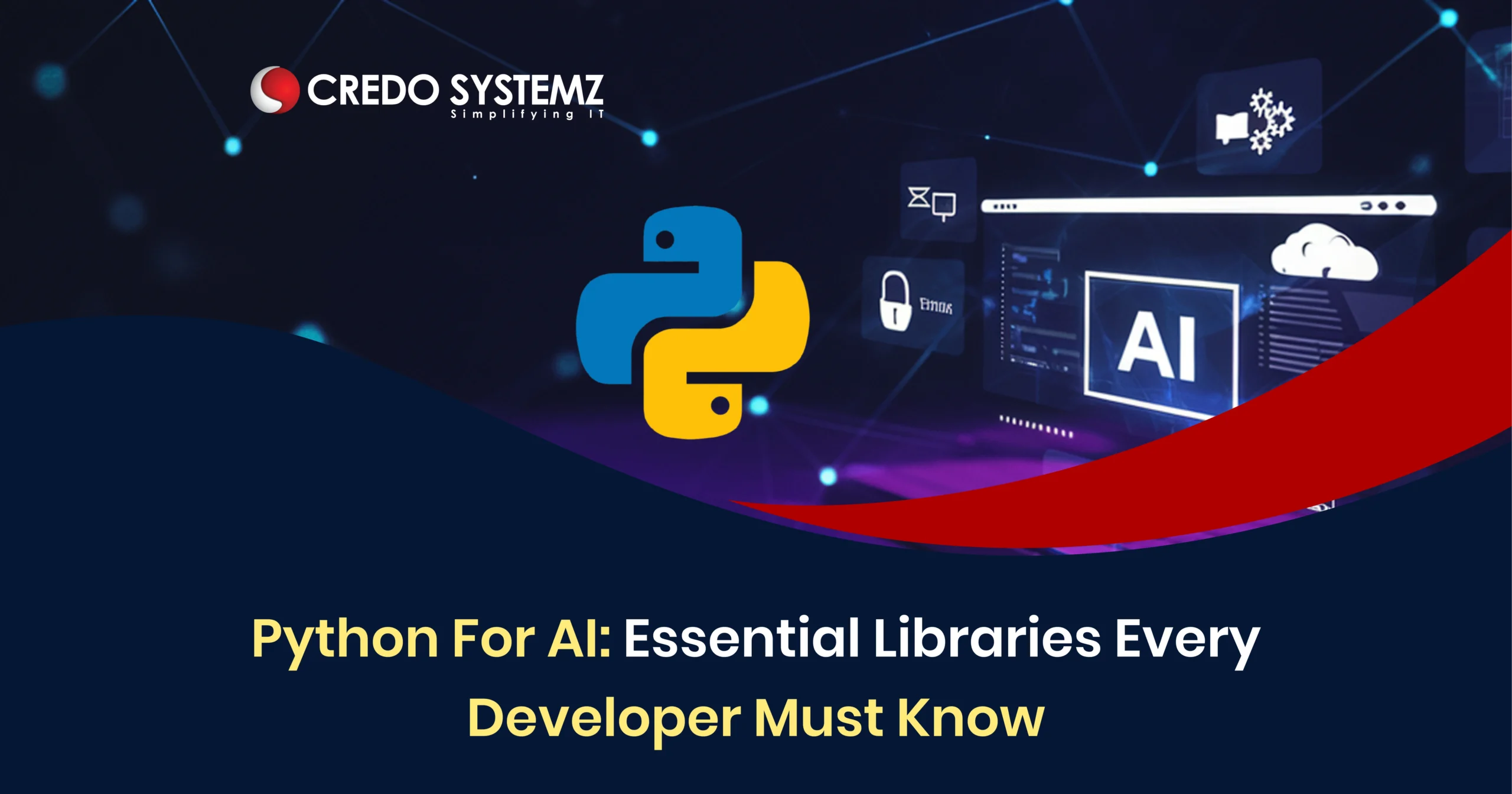
Introduction
In today’s AI world, Python has become the backbone of Artificial Intelligence (AI) development due to its simplicity, flexibility, and massive ecosystem of powerful libraries. If you are building a chatbot, training deep learning models, or analyzing massive datasets, Python provides the essential tools to turn ideas into intelligent systems. Let’s explore the most essential Python libraries for AI that every developer should master.
Essential Python libraries for AI
- NumPy — The Foundation of Numerical Computing
- Pandas — Data Manipulation Made Easy
- Matplotlib & Seaborn — Data Visualization Powerhouses
- Scikit-learn — The Go-To Machine Learning Library
- TensorFlow — Deep Learning at Scale
- PyTorch — Flexible Deep Learning Framework
- Keras — High-Level Deep Learning Simplified
- NLTK & SpaCy — Natural Language Processing (NLP)
- OpenCV — Computer Vision Made Simple
- XGBoost — Gradient Boosting for High Accuracy
NumPy — The Foundation of Numerical Computing
Numerical Python is the fundamental library for scientific computing in Python that provides fast and efficient
- Array operations
- Linear algebra
- Mathematical functions
Key features of NumPy
- N-dimensional array (ndarray) objects
- Vectorized operations for faster computation
- Integration with TensorFlow, PyTorch, and scikit-learn
Example:
import numpy as np
arr = np.array([1, 2, 3, 4])
print("Mean:", np.mean(arr))
Pandas — Data Manipulation Made Easy
AI models rely heavily on high-quality, structured data. Pandas is suitable for cleaning, transforming, and analyzing datasets with its DataFrame structure.
Key features of Pandas:
- Easy data cleaning and preprocessing
- Handling of missing or inconsistent data
- Integration with visualization and ML libraries
Example:
import pandas as pd
data = pd.read_csv("data.csv")
print(data.describe())
Matplotlib & Seaborn — Data Visualization Powerhouses
Visualization helps developers to understand data trends and model performance. Matplotlib provides basic plotting and Seaborn builds on top of it for more attractive and statistical visualizations.
Key features of Matplotlib & Seaborn
- Line, bar, scatter, and histogram plots
- Heatmaps, correlation plots, and advanced visuals
- Ideal for exploratory data analysis (EDA)
Example:
import seaborn as sns
import matplotlib.pyplot as plt
sns.heatmap(data.corr(), annot=True)
plt.show()
Scikit-learn — The Go-To Machine Learning Library
Scikit-learn simplifies machine learning with pre-built algorithms for classification, regression, clustering, and dimensionality reduction. It is perfect for both beginners and professionals.
Key features of Scikit-learn
- Ready-to-use ML models
- Model evaluation tools (accuracy, precision, recall)
- Pipelines for automation
Example:
from sklearn.linear_model import LinearRegression
model = LinearRegression()
model.fit(X_train, y_train)
predictions = model.predict(X_test)
TensorFlow — Deep Learning at Scale
TensorFlow is a leading framework for deep learning and neural network development which is developed by Google. It supports everything from image recognition to NLP and reinforcement learning.
Key features of tensorflow:
- GPU acceleration
- TensorBoard for visualization
- Works seamlessly with Keras
Example:
import tensorflow as tf
model = tf.keras.Sequential([
tf.keras.layers.Dense(64, activation='relu'),
tf.keras.layers.Dense(10, activation='softmax')
])
PyTorch — Flexible Deep Learning Framework
PyTorch offers a more “Pythonic” approach to deep learning that is developed by Meta (Facebook). It is widely used in research for its flexibility and dynamic computation graphs.
Key features of Pytorch:
- Dynamic computational graphs
- GPU support via CUDA
- Extensive model library (torchvision, torchaudio)
Example:
import torch
import torch.nn as nn
x = torch.randn(10, 5)
linear = nn.Linear(5, 2)
print(linear(x))
Keras — High-Level Deep Learning Simplified
Keras acts as a simple interface to build and train neural networks without deep TensorFlow coding. It is user-friendly, modular, and ideal for fast prototyping.
Key features of keras
- Layer-based model building
- Simple APIs for beginners
- Compatible with TensorFlow backend
Example:
from keras.models import Sequential
from keras.layers import Dense
model = Sequential([
Dense(64, activation='relu'),
Dense(10, activation='softmax')
])
NLTK & SpaCy — Natural Language Processing (NLP)
NLTK & SpaCy libraries help process and analyze human language data. Natural Language Toolkit (NLTK) is great for linguistics research, while SpaCy is optimized for production-level NLP pipelines.
Key features of NLTK & SpaCy
- Tokenization, POS tagging, named entity recognition
- Pre-trained language models
- Easy integration with ML frameworks
Example:
import spacy
nlp = spacy.load("en_core_web_sm")
doc = nlp("Python is powerful for AI.")
for token in doc:
print(token.text, token.pos_)
OpenCV — Computer Vision Made Simple
OpenCV (Open Source Computer Vision) is the go-to library for image and video analysis. It powers applications in face detection, image processing, and object tracking.
Key features of OpenCV
- Real-time image processing
- Integration with deep learning models
- Supports multiple languages and platforms
Example:
import cv2
img = cv2.imread("image.jpg")
gray = cv2.cvtColor(img, cv2.COLOR_BGR2GRAY)
cv2.imshow("Gray Image", gray)
cv2.waitKey(0)
XGBoost — Gradient Boosting for High Accuracy
XGBoost is a powerful library for building highly efficient and accurate ML models. It is particularly effective for structured/tabular data and is a favorite in data science competitions.
Key features of XGBoost
- Boosted decision trees
- Handles missing data gracefully
- Extremely fast and scalable
Example:
import xgboost as xgb
model = xgb.XGBClassifier()
model.fit(X_train, y_train)
Conclusion
Finally, Python continues to dominate AI development because of its simplicity and the rich ecosystem of libraries it offers. Pandas (data manipulation) and Scikit-learn (machine learning), TensorFlow, PyTorch (deep learning) and SpaCy, NLTK (NLP) libraries form the foundation of every AI engineer’s toolkit. If you’re an aspiring AI developer, mastering these libraries by joining Credo Systemz Python with AI training as it is the first big step toward building intelligent, data-driven systems.

Join Credo Systemz Software Courses in Chennai at Credo Systemz OMR, Credo Systemz Velachery to kick-start or uplift your career path.
